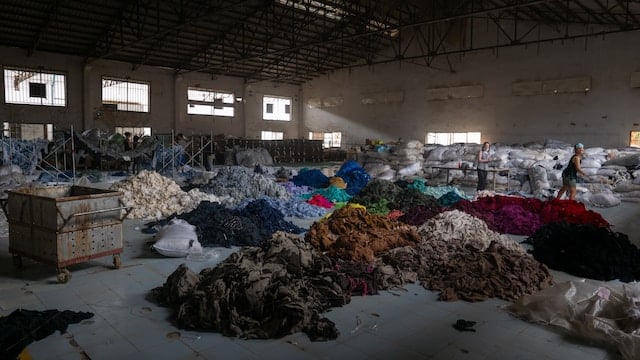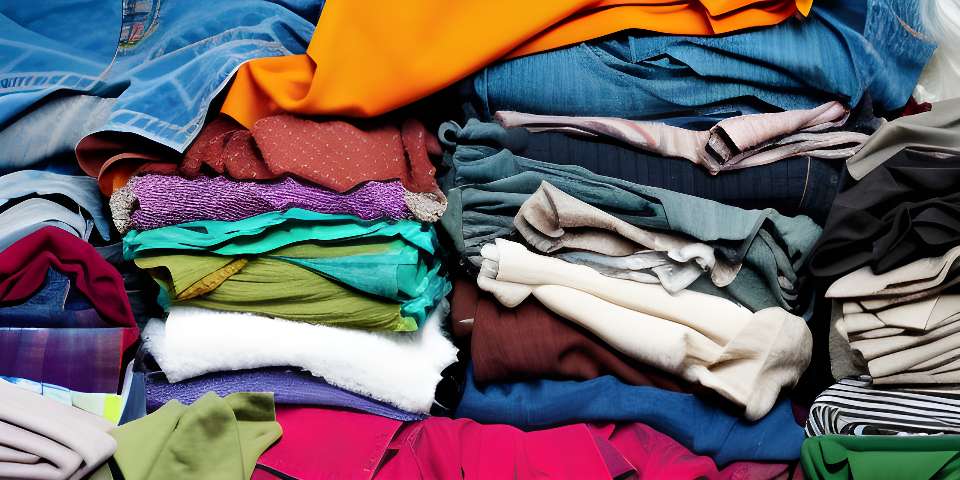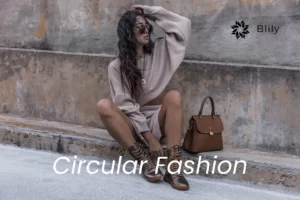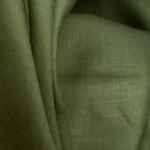Tanace Organics Pvt. Ltd

From Trash to Trend: How Recycled Clothing is Redefining Fashion.
Recycling clothes is an idea that has seen some good strides in the fashion world lately. It refers to clothing and accessories made using recently used materials, such as repairing clothes or waste materials and turning them into beautiful and wearable models. This interaction reduces waste and improves sustainability and ethics in business development.
Briefly explain the concept of recycled clothing and its significance in the fashion industry.
The purpose of recycled clothing is to work to reduce environmental pollution. The manufacturing industry is known for its waste and pollution, with tons of clothing thrown into landfills each year. By processing recycled clothing, buyers and patternmakers can use recycled materials from landfills, reducing interest in new products and conserving valuable resources.
Highlight the increasing demand for sustainable fashion.
The purpose of recycled clothing is to work to reduce environmental pollution. The manufacturing industry is known for its waste and pollution, with tons of clothing thrown into landfills each year. By processing recycled clothing, buyers and patternmakers can use recycled materials from landfills, reducing interest in new products and conserving valuable resources.
Table of Contents
The Process of recycled clothing
The process of using recycled materials includes several stages and uses a variety of technologies and methods to transform waste clothing into new products. Let’s take a closer look at the basic steps involved:
- Collection
- Sorting
- Cleaning
- Shredding
- Fiber Reclamation
- Spinning or Felting
- Recycling of Non Fiber components

Collection
The main stage of recycling is the separation of waste clothing. This can be done in a variety of ways, such as gift shops, thrift shops, recycled products or special services. Collected garments were classified according to their condition, texture type and quality.
Sorting
After cleaning, clothing items are prepared according to various rules. This often involves sorting them by texture type (cotton, polyester, wool, etc.), variety, and condition. Appointments ensure that the recycling process proceeds efficiently and adequately.
Cleaning
Upon appointment, the suit receives a wash interaction to remove any dirt, stain or foreign matter. This is important to ensure good data for reuse. Cleaning techniques may include washing, steaming or using solvents that are not harmful to the ecosystem.
Shredding
After washing, the clothes break into small pieces. This cycle divides the tissue into strips, making it easier to work in the next step. Often waste material is added according to the fiber type and type to maintain the consistency of the recycled material.
Fiber Reclamation
At this stage, the fiber, from which the individual strands are separated, restores the tissue. Wires can be separated by tissue using methods such as mechanical intervention, a combination, or a combination of the two.
Spinning or Felting
Recovered filaments can be turned into new yarns that are used to create the texture of new garments. Filaments, on the other hand, can be felt, strong interactions, moisture and filters are used to bind the strips together, resulting in non-woven materials or materials such as a protective material block or cleaning cloth.
Recycling of Non Fiber components
It is important to remember that the recycled material is around the fiber content and identifies different parts of the garment such as buttons, zippers and tabs. These items can be separated, organized and reused independently to limit waste and maximize asset recovery.
Discuss various technologies and techniques employed in recycling.
Different advancements and techniques are used throughout the product recycling process. Advances in recycling technology, recycling and advanced technology have resulted in improving and expanding the range of recycled materials. In addition, advances in fiber-to-fiber reuse techniques allow the development of reusable fibers that can be compared to virgin materials in processing.
By using these innovations and ideas for recycling, businesses can reduce their natural impact, average assets and increase business efficiency again.
Benefits of Wearing Recycled Clothing
Recycling clothing has many environmental benefits and helps reduce waste and conserve resources. It also has unique and stylish options for people. Let’s examine these advantages in detail:
- Waste Reduction
- Resource Preservation
- Reduction Of Carbon FootPrint
- Unique Fashion Options
- Ethical and sustainable Fashion

Waste Reduction
People are joining efforts to reduce waste by deciding to wear reusable clothing. Industrial design is known for taking strict measures for waste, which is an important part of waste. Choosing reusable clothing can limit the ecological impact of discarded clothing by removing materials from landfills and extending their lifespan.
Resource Preservation
People are joining efforts to reduce waste by deciding to wear reusable clothing. Industrial design is known for taking strict measures for waste, which is an important part of waste. Choosing reusable clothing can limit the impact of waste clothing by transferring materials from waste disposal sites and extending their life.
Reduction Of Carbon Footprint
The carbon footprint of the manufacturing industry is important mainly because of the large amount of energy associated with manufacturing. Recycled clothing reduces fossil fuel emissions by limiting the need for new assembly processes. Choosing reusable clothing can help prevent environmental change by reducing emissions of ozone-depleting pollutants.
Unique Fashion Options
The carbon footprint of the manufacturing industry is important mainly because of the large amount of energy associated with manufacturing. Recycled clothing reduces fossil fuel emissions by limiting the need for new assembly processes. Choosing reusable clothing can help prevent environmental change by reducing emissions of ozone-depleting pollutants.
Ethical and Sustainable Fashion
Promote the use of recycled clothing in good practice and management. By choosing clothing made from recycled materials, people can join an environmental business designed to reduce waste, increase value and focus on good practices. This buyer’s decision drives fashion brands to be more creative and profitable for the entire industry.
Fashion Industry’s Response to Recycling
The established business is aware of the need for management and has increasingly started to use different support methods to solve natural problems. This chapter will explore how fashion brands embrace recycling, collaboration with ecological organizations, and the concept of creating a circular economy.
- Adoption of Sustainable Practice.
- Many retailers integrate reusable materials into their collections. They use innovative techniques to transform recycled materials into high-quality materials and increase the value of antiques.
- Products can enter employment with the assurance that their information is appropriate and appropriate. This includes the use of natural, fair trade and eco-compatible materials.
- The fashion industry uses eco-conscious assembly methods, such as reducing water use and limiting organic and energy-efficient production processes.
- Some businesses are looking at the first option, such as leasing and property management, to use design in a more controlled way.
- Collaborations with Environmental Organizations:
- The design includes collaboration with ecological organizations to promote positive change. These collaborations promise to shed light on the question of the economy’s impact on fashion and advanced applications.
- Collaborate to support development around learning, testing and business innovation. They promote knowledge sharing and maintain an enterprise-wide ecospace culture.
- The Eco-Association often works closely with design to improve the timeliness, ethics, and knowledge recognition of production networks.
- Circular Fashion Economy:
- The business round about concept envisions closing the circle where materials are continually reused, reducing waste and limiting the need for innovation.
- With activities that ensure sustainability, fashion products are round, the firsts of renewal and renewal. They are working on recycling to collect and reuse end-of-life clothes.
- Companies are exploring recycling ideas that can turn used materials into new filaments, closing the loop and reducing reliance on virgin resources.
- Collaboration between products, consumers and recycling centers fosters a culture of recycling, reconditioning and repurposing of clothing, preventing product longevity and limiting disposal.
Incorporating Recycled Clothing into Your Wardrobe:
- Thrifting and Vintage Shopping Tips:
- Investigate secondhand shops, transfer shops, and one of a kind stores for special and reasonable recycled clothing finds.
- Search for ageless pieces like denim coats, jackets, and excellent fundamentals that can be effortlessly integrated into your closet.
- Keep a receptive outlook and take a stab at various styles and sizes to find unlikely treasures.
- Check for any indications of wear and examine the dress cautiously prior to making a buy.
- DIY Upcycling Ideas for Old Clothing:
- Transform old t-shirts into trendy crop tops or tank tops by cutting and resewing them.
- Give jeans a new life by distressing them or adding patches for a personalized touch.
- Repurpose old scarves or fabric scraps into headbands, scrunchies, or unique accessories.
- Turn oversized shirts into stylish dresses or skirts by altering the fit or adding a belt.
- Explore online tutorials and upcycling communities for more creative ideas.
- Styling Tips for Incorporating Recycled Fashion:
- Mix and match recycled pieces with your existing wardrobe to create unique outfits.
- Layer vintage blouses or jackets over modern basics for a stylish contrast.
- Use recycled accessories like statement jewelry, belts, or bags to add a pop of personality to your look.
- Experiment with different textures and patterns by combining recycled clothing items.
- Don’t be afraid to embrace your own style and express your individuality through recycled fashion.
By following these tips, you can incorporate recycled clothing into your wardrobe, adding sustainability and personality to your personal style.

Emerging Designers and Sustainable Fashion
Leaders in the fashion industry are on the rise and working hard to manage the app. These projects push the boundaries of eco-compulsion using thoughtful materials and programs. Also, fashion shows and events joined forces to promote and showcase recycled clothing. How do we control these thoughts:
- Notable Designers Embracing Sustainable Practices:
- Stella McCartney: Known for her obligation to sustainable fashion, Stella McCartney utilizes vegan and eco-accommodating materials in her plans. She advances moral and straightforward stock chains and advocates basic entitlements.
- Mara Hoffman: Mara Hoffman centers around making dynamic and smart attire utilizing dependable obtaining and creation techniques. She integrates reasonable materials like natural cotton, hemp, and reused textures into her assortments.
- Maggie Marilyn: This New Zealand-based brand is committed to manageability and moral practices. They focus on fair wages and make pieces of clothing utilizing natural and reused materials, with an emphasis on straightforwardness all through the store network.
- Bethany Williams: Bethany Williams joins social activism with sustainable fashion. She teams up with minimized networks and uses reused and upcycled materials to make exceptional, socially cognizant plans.
- Innovative Materials and Techniques in Sustainable Fashion:
- Pinatex: Made from pineapple leaf fibers, Piñatex is a sustainable alternative to leather. It offers a cruelty-free and eco-friendly option for fashion designers.
- Econyl: Econyl is a regenerated nylon fabric created from recycled fishing nets and other nylon waste. It has gained popularity as a sustainable material for swimwear and activewear.
- 3D Printing: 3D printing technology allows for the creation of garments with minimal waste and precise customization. Designers are exploring this technique to reduce material consumption and promote sustainable production.
- Fashion Shows and Events Promoting Recycled Clothing:
- Copenhagen Fashion Summit: This annual event brings together fashion industry leaders to discuss sustainability and drive positive change. It focuses on topics such as circularity, innovation, and responsible production.
- Eco Fashion Week: Held in various locations worldwide, Eco Fashion Week showcases designers who prioritize sustainable practices and create fashion with minimal environmental impact.
- ReFashion Week NYC: This event highlights the importance of recycling and upcycling in the fashion industry. It features runway shows, panel discussions, and workshops centered around sustainable fashion.
What Textiles Are Eligible to be Recycled?
A wide variety of textiles are eligible to be recycled, contributing to more sustainable and eco-friendly practices in the fashion and textile industries. These textiles encompass clothing, household items, and fabrics used in various applications.
Firstly, clothing made from natural fibers like cotton, wool, silk, and linen can be recycled. These fibers can be broken down and reprocessed into new yarns or fabrics. However, the quality of the recycled fibers may be slightly lower than the original ones due to the degradation that occurs during recycling.
Secondly, synthetic textiles, including polyester, nylon, and spandex, can also be recycled. Technologies have been developed to break down these materials into their original polymer forms, which can then be used to create new fibers or fabrics. Recycling synthetics helps reduce the demand for virgin petroleum-based materials and decrease the environmental impact of these synthetic fibers.
Thirdly, blends of natural and synthetic fibers can also be recycled, although the process is more complex due to the different properties of each fiber type. Research and advancements in recycling technology are ongoing to improve the recycling rates of blended textiles.
Lastly, accessories like belts, bags, and shoes can be recycled, often through specialized programs that collect and process these items for reuse or material reclamation. Additionally, household textiles such as curtains, bedding, and towels can be recycled, reducing their contribution to landfills.
It’s important to note that the feasibility of textile recycling can vary based on factors like fiber content, condition, and local recycling infrastructure. As technology advances and awareness grows, the range of textiles eligible for recycling will likely expand, contributing to a more sustainable and circular fashion and textile industry.
Environmental Impact of Fashion
The fashion industry has a huge impact on the environment, especially in terms of pollution from textile production and the consequences of fashion. However, health awareness is on the rise, encouraging people to make more choices. Let’s explore this:
- Pollution Caused by Textile Production:
- Water Pollution: Textile production involves extensive water usage and the release of harmful chemicals and dyes into waterways. This contaminates freshwater sources and affects aquatic ecosystems.
- Air Pollution: The fashion industry contributes to air pollution through the emission of greenhouse gases, volatile organic compounds (VOCs), and particulate matter during manufacturing processes.
- Chemical Pollution: Hazardous chemicals, such as pesticides, insecticides, and toxic dyes, are used in growing fibers and treating fabrics. These chemicals can have adverse effects on the environment, wildlife, and human health.
- Consequences of Fast Fashion:
- Overconsumption: Fast fashion encourages the rapid turnover of clothing, leading to excessive consumption and waste generation. The pressure to keep up with trends contributes to a culture of disposable fashion.
- Landfill Waste: The discarded clothing from fast fashion ends up in landfills, as synthetic fibers take a long time to decompose. This contributes to the growing problem of textile waste.
- Poor Labor Conditions: Fast fashion is associated with exploitative labor practices, as brands prioritize low-cost production and quick turnaround times. Workers often face unsafe working conditions, low wages, and long hours.
- Encouraging Conscious Consumerism:
- Sustainable Materials: Choose clothing made from organic, recycled, or renewable materials, such as organic cotton, hemp, or recycled polyester. These materials have a lower environmental impact.
- Quality over Quantity: Opt for well-made, durable garments that will last longer, reducing the need for frequent replacements.
- Secondhand and Thrift Shopping: Explore second hand stores, online platforms, and clothing swaps to extend the life cycle of clothing items and reduce demand for new production.
- Support Sustainable Brands: Seek out and support fashion brands that prioritize sustainable and ethical practices, such as fair wages, transparent supply chains, and eco-friendly materials.
- Care and Repair: Take care of your clothing by following proper care instructions, repairing items when needed, and exploring DIY techniques to give old garments a new life.
Conclusion
Recycled clothing has played an important role in reviving the fashion industry and promoting sustainability. By choosing recycled clothing, people can help reduce waste, conserve resources and reduce the fashion industry’s environmental impact. The benefits of recycled clothing go beyond the environment.
It has unique fashion choices that allow for self-expression and promote ethics and culture. Embracing sustainable fashion is essential to create a responsible and conscious business. As consumers, we have the power to drive change through our choices. By recognizing consumer products, promoting sustainable brands, and incorporating recycled clothing into our clothing, we can make a positive impact on the environment and support the development of the fashion industry.







